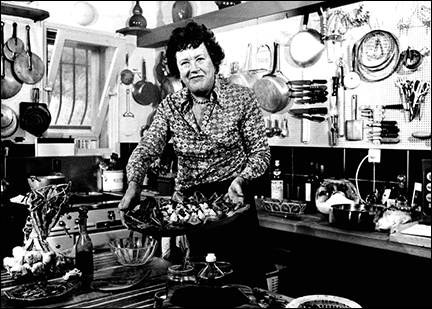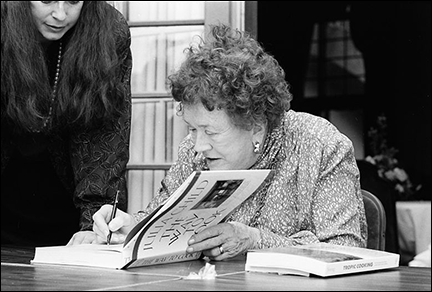The late Julia Child (d. 2004) is world famous for her gastronomic talents and relaxed approach to cooking. In her early career, Child focused mainly on French cuisine. As time passed, she created recipes that seemed simple to prepare using only standard ingredients.
 Who is Julia Child?
Who is Julia Child?
Julia Child is renowned for introducing French cooking to the public with the release of her best-selling cookbook Mastering the Art of French Cooking (1971), and her popular TV shows that included The French Chef (1963-1973), Julia & Jacques Cooking at Home (22 shows), and many others.
Child prided her cooking style on the very fine details of each ingredient she used in recipes. She worked with basic, everyday ingredients that could turn a TV chicken dinner into a five-star Coq au Vin dish. She was motivated to work with a wide range of contemporary chefs. In fact, Child was greatly influenced by chef Jacques Pepin’s French cuisine and modern cooking style, especially as she developed and refined her own culinary skills. Watching T.V. reruns of these two lovers of French cuisine as they candidly and charmingly cooked full meals together is priceless. The banter between Child and Pepin was out of mutual respect for each other and they both enjoyed using their different cooking styles in tandem. The dual effect was extraordinarily beneficial to Child’s wide audience.
In this video, a collection of highlights from Cooking at Home: Julia Child & Jacques Pepin, watch how Child and Pepin work together and play off of each other’s personality and cooking styles.
Child became widely popular because she knew how to present herself directly to her audience. This feeling of direct communication helped grow her fan base because viewers felt her warmth and shared in her laughs. Audiences loved this aspect of her TV persona. More importantly, Child prepared dishes with creative flair and appetite appeal, yet she made her meal preparations appear simple enough for novice cooks to attempt.

Publisher Alfred A. Knopf published Child’s first cookbook in 1961, a 700-page hardback called Mastering the Art of French Cooking. Still in print today, cooking enthusiasts consider it as one of history’s most influential culinary books. In 1980 Child won the U.S. National Book Award for her 1979 cookbook, Julia Child and More Company.
So what can you learn from her approach to cooking?
Here are seven tips I learned and would like to pass on to you:
Tip 1. As one who wants to write on the broad and niche topics of food, you can write your evaluation of a chef, your thoughts on the latest paleo recipes, meal delivery service reviews, or even your examination of renowned food emporiums. These could project haute cuisine in an elegant style and presentation. This always attracts the attention of gastronomic readers. This writing approach creates an impression of the most popular ingredients, newest restaurant trends, chefs, and recipes.
Tip 2. One obvious skill that you must develop is learning how to write descriptively from what you experience through your five senses: sight, hearing, taste, smell, and touch. Combine a dash of light humor with your well-focused food article that clearly defines its purpose. Recreate a signature writing style of your own.
Tip 3. Collectors of recipes often become annoyed when realizing the writer had omitted or reduced the importance of certain ingredients. It’s important that if you add a recipe as part of an article or a book that you follow the recipe’s steps yourself and determine if it requires additional details or not.
Tip 4. When you decide what food topic you want to write on, plan out an introduction or sidebar that will suggest side dishes or condiments, such as appetizers, garnishes, after dinner wines, and recommended desserts. These can be supported by comments or quotes from top chefs or reputable restaurants. This will give your article greater credibility.
Tip 5. You can learn the value of sharing and exchanging ideas about food ingredients and cooking styles from watching any episode of Child’s cooking show. A food article that provides different viewpoints and shares techniques from other chefs will greatly interest readers. Plus, writing specifically to the tastes and interests of your readers will build a loyal following.
Tip 6. Each food article could project culinary content in a progressive manner. As Child did with her TV audience, you, too, should welcome novice foodies into your readership of experienced gastronomes.
Tip 7. Child respected other culinary styles and approached her cooking with humility. You may find writing styles of professional food writers essential to your progress. This doesn’t mean copying or emulating other writing styles. It simply means that you can improve your own writing talents by learning proven writing methods used by seasoned food writers, especially methods that are different from your own.



